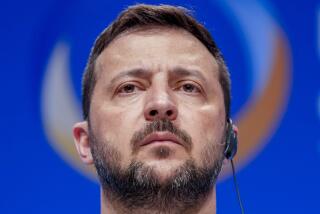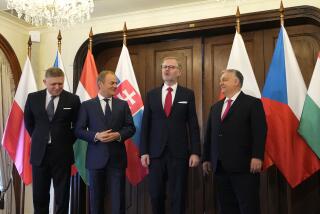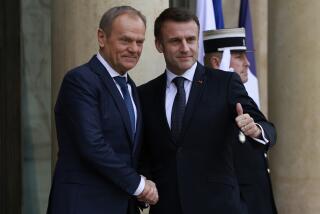Unity Conference in Poland Reaches Back 1,000 Years
- Share via
GNIEZNO, Poland — The presidents of Germany and four former Soviet bloc countries gathered here Sunday in an effort to use the memory of a 1,000-year-old meeting between a German emperor and Poland’s first king as a force for the post-Cold War unification of Europe.
Sunday’s summit reverberated with echoes of that March 1000 encounter between German Emperor Otto III, also recognized as the Holy Roman emperor, and Poland’s Boleslaw I Chrobry, also known as Boleslaus the Brave.
Their meeting, which marked Poland’s acceptance into the medieval community of European Christian nations, is now seen by many as a forerunner of today’s attempts to integrate former Communist countries into Europe’s mainstream.
The five presidents drew that parallel in a joint “millennium appeal” read by Polish President Aleksander Kwasniewski outside Gniezno Cathedral, next to a huge statue of Boleslaw holding a sword.
The meeting of Otto III and Boleslaw was “part of the joint plans of Emperor Otto III and Pope Sylvester II to ensure European unity under a new form of universal empire by uniting Italy, Gaul, Germany, Slavonic lands and Hungary,” the summit statement said.
“Today, as we recall the events of history and the farsighted designs of great European visionaries, we are looking to the future,” the presidents’ statement continued. “At the threshold of the Third Millennium, Europe faces a historic opportunity of secure development and permanent integration. Let us do everything not to forfeit that great chance!”
Besides Kwasniewski, the presidents at Sunday’s summit were Germany’s Johannes Rau, Hungary’s Arpad Goncz, Slovakia’s Rudolf Schuster and Lithuania’s Valdas Adamkus. Pope John Paul II was represented by Cardinal Angelo Sodano, secretary of state of the Holy See.
Ukraine’s Leonid D. Kuchma canceled because of a mine accident in his country Saturday that killed 81 people. The Czech Republic’s Vaclav Havel stayed home suffering from bronchitis.
The summit was held on a cold but sunny day in a festive atmosphere. About 2,000 area residents gathered in Gniezno’s Old Town Square to watch a military honor guard, marching band and folk dance troupe welcome the presidents.
Later, a visibly happy crowd of similar size gathered outside the cathedral, where the five leaders attended an ecumenical service at the tomb of St. Adalbert, a missionary priest who died a martyr’s death in 997 and was canonized two years later. Otto III came to Gniezno in 1000 not only to meet Boleslaw but also to pray at St. Adalbert’s tomb.
Agata Michalczyk, 19, who was outside the cathedral with her high school classmates, said their group had come because “it’s a historic event.”
“It happens once in a millennium,” she declared. “Not everyone has a chance to live through it. It’s an occasion to show ourselves to the world.”
The five presidents also appeared jointly in a television discussion during which they stressed the need to expand the European Union based on a set of shared values.
Kwasniewski, speaking with reporters at the end of the summit, was the most blunt in expressing the message he saw in the day’s events.
“This meeting in Gniezno has great importance,” he said, “because it reminds Europe: ‘Listen, something happened here already 1,000 years ago, and we are following the road which was drawn a long time ago. Poland is not a new partner on this road [to a] Europe that will be united thanks to, among other things, such people as Otto III, Boleslaus the Brave, St. Adalbert and Pope Sylvester II.’ ”
More to Read
Sign up for Essential California
The most important California stories and recommendations in your inbox every morning.
You may occasionally receive promotional content from the Los Angeles Times.










